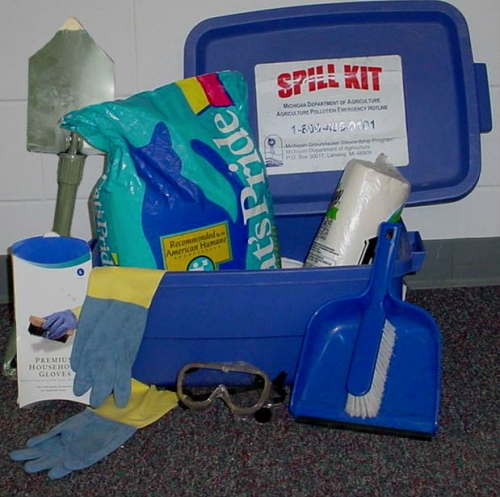Chemical spills: Take quick action to avoid injury
Knowing what to do when a spill occurs protects you, your family and helps safeguard Michigan’s water resources.
 Chemical spills do happen. It may be a small spill that you can handle with a spill kit or one that you are not able to handle yourself. In either case, the trick is to be prepared.
Chemical spills do happen. It may be a small spill that you can handle with a spill kit or one that you are not able to handle yourself. In either case, the trick is to be prepared.
When a spill occurs, follow these steps of proper spill response:
- Caution
Always assess the dangers of a spill or release first. If a spill cannot be controlled or contained without endangering life or safety, call 911 immediately. - Control
If possible, control the source of the spill. Shut valves, plug leaks or set container upright. Note: don’t attempt to control the spill if you don’t have the proper personal protective equipment needed to handle dangerous chemicals. - Contain
Stop the spread of the spill and contain it to as small an area as possible and away from groundwater, surface water, wells, storm drains or floor drains. Use a shovel to make a soil berm around the spill or apply an absorbent material such as cat litter. - Contact
If necessary, contact the appropriate authorities. If the spill is a danger to health or safety, immediately call 911. If there is a danger to groundwater or surface water, call the Michigan Department of Environmental Quality Pollution Emergency Hotline: 1-800-292-4706. - Clean up
For a dry spill, use the broom and dustpan to sweep up the product and then dispose of it property or use it as intended.
For a wet spill, use cat litter, activated charcoal, soil or sawdust to absorb the chemical, then sweep it up and dispose of it material properly. Take contaminated materials to a local household hazardous waste collection program or contact a local Clean Sweep collection site. Never wash a spill down a drain as most drains lead directly to lakes, rivers or streams.
For more information on preventing environmental contamination risks in and around the home, an excellent resource is the “Home*A*Syst – Home Assessment Guide (WQ-51),” available through the Michigan State University (MSU) Extension Bookstore.
For information on how to make a spill kit at home, see the article “Chemical spills: Build a simple spill kit at home.”



 Print
Print Email
Email


